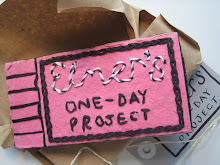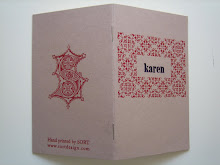
Today I hosted an informal day of bookmaking in my garden. Poets/artists Becky Cremin, Ryan Ormonde and Sejal Chad attended.
Today the book became our medium.
I've spent a bit of time (I should spend a lot more time) reading Rob Perrée's Cover To Cover, a must for anyone trying to get to grips with the long and confusing history of artists' books. Perrée talks about the collaborative nature of artists' books in which individuals engaging in their chosen medium and specialism come together in the production of one bookwork. They may include the writer, artist, designer, publisher, exhibitor etc. But any thinking, considering, making, presenting is carried out individually, separated by time, space and place. After completing one part of the bookmaking process the book is placed in the hands of someone else who sprinkles their thoughts and plays their part. There's nothing wrong with this. It's worked since the early twentieth-century but sometimes on that rare occasion for a brief while, individuals find a time, space and place in which to think and create together. And in this instance, collaboration can be and is an immediate and instantaneous exchange. Perrée provides an excellent example of this when he takes his reader to Paris to embark on a brief history of bookmaking, Parisian-style. Here, once upon a time, 'writers and artists found one another, discussed the issues together, worked together or knew one another in other ways'. Perrée calls this 'a mutual process of cross-fertilization'. Now that's something to achieve and keep going - works being made, experienced and discussed all at the same time, in the same space, in the same moment.
Ok, ambitious plans - realistically this is unsustainable as we have jobs, commitments, other places to be but today we tried it. It was nice. Really nice. Maybe there can be other days like this scattered (generously) in amongst our busy schedules.
Today we cross-fertilised for sure.

Ryan holds an awl. Sejal gets ready to type. Becky hangs it on the line.

Our work station.
Instructions for the day:
I'd like us each to make a book and fill it with material we have prepared beforehand or come up with on the day.
I'd like us to exchange our books.
I'd like us each to review the book we take away with us.
I'd like to document the afternoon and the books with photographs.
I'd like to put these images up on my blog with links to your thoughts.
I'd like us to focus on how bookmaking can be very much a collaborative process. This collaborative means of production instantly makes way for fruitful dialogue as we work alongside one another witnessing the gems and disasters of bookmaking, and are able to pose questions to those working alongside us.
I'd like it to be an afternoon that's really quite rare when it comes to the production of artists' books.
You will need paper.
You will need tools for scribing words.
You will need a needle and thread.

Cut, rip, scribe and bind!

Some handy tools.

Ryan makes his book using black gaffer tape.

After awling Ryan binds.

Becky hears and writes. Becky writes what she hears.
Here are the finished books drying on the washing line:

Ryan Ormonde, Y Chromosomes

A beautifully textured bookwork.
30 cm x 8 cm. 17 pages alternate between acetate paper and black gaffer tape. Binding with pink embroidery thread tried in a knot at seven points along the edge of the book. Text word-processed and printed onto acetate paper. Black gaffer tape represents the absent X chromosome. The ribbed underside of the tape leaves very visual markings that come through the acetate and resemble a scientific code, thus echoing the idea of chromosomes and DNA. This can be made out in the image above. The tape brings to the book intricate detail that is both visual and haptical. The layout of the text draws attention to the form of the book, in particular its length. It consists of paper which has been cut into strips and the text adapts to this form resting in narrow columns. The text is visually striking and words such as 'you' and 'and' are repeated and presented in a block column but the columns remain unfinished drawing attention to the number of words. 86 words which Ryan tells me has something to do with the make up of the Y chromosome. The visual quality of the text encourages me to read down as though I am being guided by the length of the book. I find myself reading in long strips slicing through the more conventional left to right read. I read the text longways. Ryan plays with repetition, rhythm and sounds which reverberate throughout each poem, like vibrations unfolding down the column and down the page. I particularly like Ryan's use of capitals, which grow out of words such as 'ecoKNOWmic', 'cNOversatiNO' and 'preJEWdice'. If the words are to represent parts of a gene, then it's like the gene is growing outwards - out of the 'economic' stem 'KNOW' roots outwards - and the way in which they are positioned in the text, as though in dialogue with each other. And Ryan did tell me something about genes networking and conversing with each other. Some of the poems that appear in Y Chromosomes can be found here
Becky Cremin, Baking I

Becky Cremin is a domestic goddess. Fact.
22 cm x 4.5 cm. White rag cloth cover folded around the edge to form a spine. Inside 14 pages of Newsprint paper. The second version of this book measures 19 cm x 4 cm and consists of 14 pages of green Lamali paper. Both versions include handwritten text using pen and ink. The left-hand side of each page is reinforced with a strip of masking tape for added strength when binding. Japanese Stab binding with black embroidery thread. Each version is unique and consists of hand-cut handmade paper, self-bound with a handwritten text. The text comes from a series of sonnets produced by Becky and have also been baked in a oven (see below). Each book is a different sonnet. On each page is scribed a line from the sonnet. The pen and ink bleeds through the light Newsprint and Lamali paper creating smudges and splatters of black ink. You can't help but notice how Becky's choice of materials and method of making acts as a visual aid to the content: 'hand clean skin' - the paper is skin like, 'tears butter grams' - the paper is torn, 'melting spread' - the ink on paper, 'hand over wrist' - the motion of handwriting. The text not only relates to the domesticated act of baking but also the act of handcrafting. Becky also plays with a range of textures clearly marking/recording/performing the scratching of her ink pen on the rough surface of the rag cloth cover.
Sejal Chad, when you hand(L)ed me

The only illustrated book of the day.
15 cm x 10.5 cm. Red cover card for front and back cover. Pink and red card inside on to which is taped, stapled and stitched acetate paper filled with text and sketches in black Biro. Book bound together using a two-staple bind with additional black embroidery stitching along the spine and continues to form border on the front cover. This is quite obviously a self-conscious book, an inside-out book, where all it's processes of making are exposed on each page. The acetate allows for all stitching to be unveiled. It is multi-layered in its use of materials and the way in which the paper is attached on top of one another creating a multi-layered text. You follow the text through the acetate and on to the card for a multi-layered reading. Each page is unique due to the craft processes Sejal employs but it retains coherence through Sejal's style of text and image. This is definitely a book to be hand(l)ed. Unfortunately, I don't have a copy of the text but I remember that reading it is like the black thread that makes its way from cover to cover. When reading Sejal's text I find myself trying to thread together the text with the conversations, music and happenings that occurred today. Also, the sketched pigs resemble those in Richard Scarry's 'Biggest World Book Ever!'
Me, ELLE is one big issue (April '09)

14.5 cm x 9.5 cm. Pink foam board front and back cover. Text on front cover hand stitched in a chain stitch and loose stitch using black cotton thread. Japanese Stab binding with black cotton thread also. Inside 12 pages hand-cut from an old journal. Text typewritten. The text comes from the April '09 edition of ELLE magazine which I bought in March and never got round to reading. I read the magazine yesterday including all PL codes and cosmetic small print. Words were selected, noted and written through to create an alternative narrative for the April issue of ELLE. The text can be found here
Becky also baked homemade cakes with a surprise poem-filled centre.


Above is the poem that was baked in my cupcake. Delicious cakes and evocative poems. Language of a domestic discourse has been cut, blended and literally baked to explore the notion of a female (domestic) goddess - my favourite line: 'She waits in domestic wire blending hours'. Read more about Becky's thoughts on "performing" domesticity here
Below are our thoughts on the day ( kindly transcribed by Becky):

So to end with Perreé. I think, we found each other to have a similar interest - books, childhood and positive thinking. We did spend some of today discussing issues surrounding 'the book' and our books, childhood and positive thinking. And we did work together not on the same book or anything, but together nonetheless. Gush!





![five [yellow] poems](https://blogger.googleusercontent.com/img/b/R29vZ2xl/AVvXsEj7pWNS6-0OLKnVlSKvxNZqflLcymygEpr7SKNZ6DxOw2ujEBwCNVmJyjSNWrwfRduPucxM75xqy150M74MeXwHdLaK8OEy3vX-qNnWPPAj4JQiJA_hiqwlqGsxHqQ9Lzf4ANVHutXo7jRQ/s220/book2.JPG)















3 comments:
What a thorough write-up! I was grinning all the way through - a loving document of a day of lovingly crafted texts - bring on the sequel xxxxx
Thank you for this Karen
I agree with the above! This is a great document of this day and you have taken so much care, (I know I giggled when you got out your ruler) to document this day so beautifully. I also think there should be more, these days bring hope into my life! It was amazing and thanks for all these words!
xox
Just found out what typefaces I used for the y chromosomes book: courier new and BATANG
xxx
Post a Comment